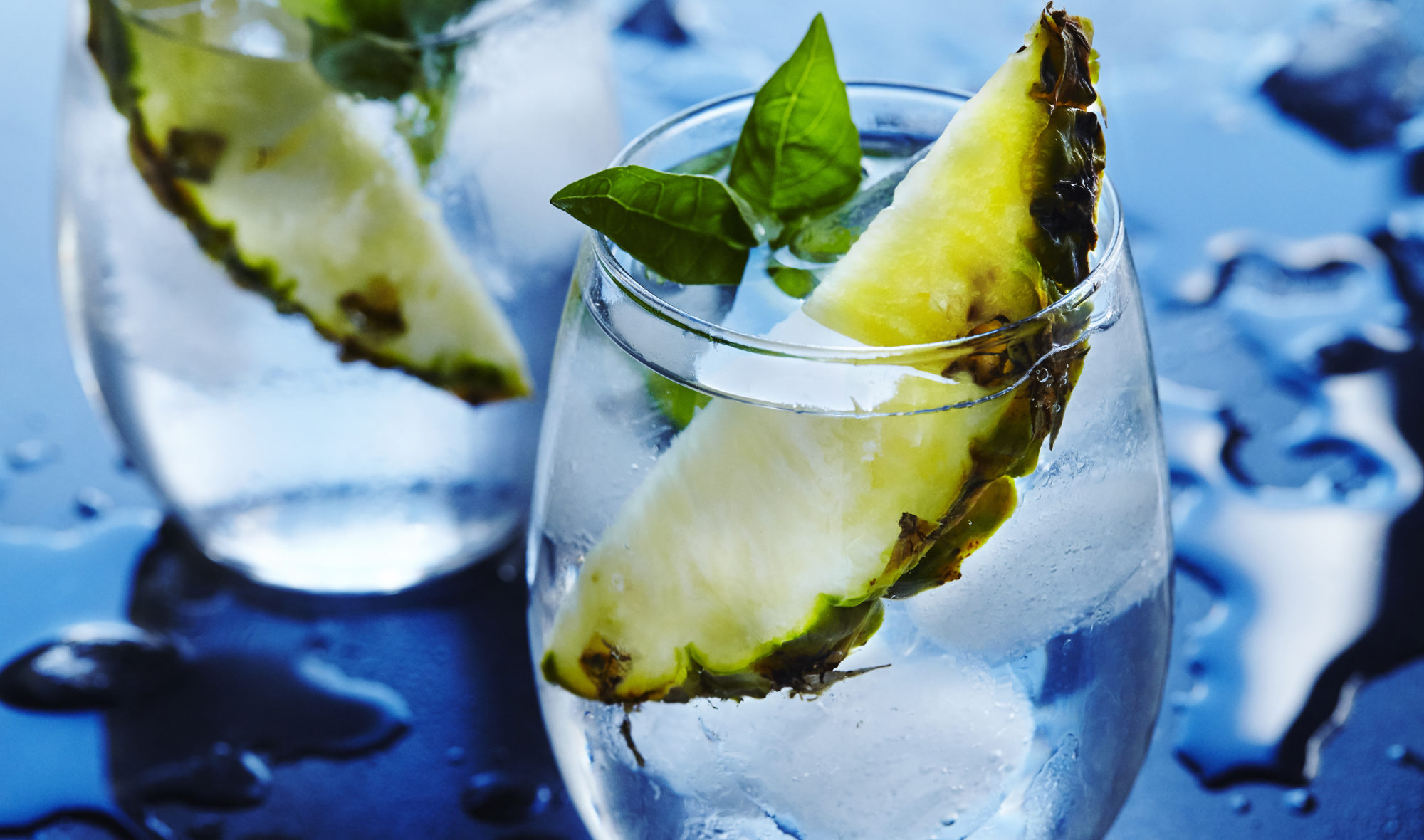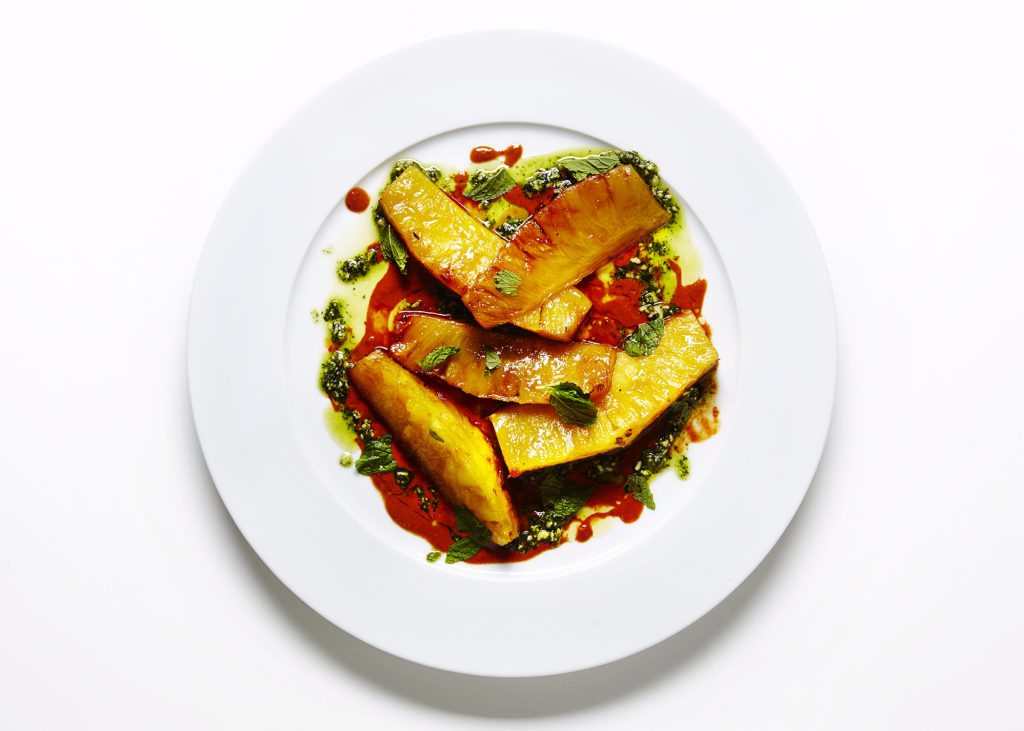
🎁 Holiday Special: SAVE 52% on the Nutrition Coach Starter Package. Limited number remaining.

🎁 Holiday Special: SAVE 52% on the Nutrition Coach Starter Package. Limited # left.

The pineapple is a sweet and punchy tasting tropical fruit with a nubby, yellowish body and a tufted crown of leaves. Raw pineapples are an excellent source of vitamin C, and a good source of manganese and copper. Pineapples also contain bromelain, an enzyme that may promote digestion and reduce inflammation. Although pineapples require a little muscle to prepare, they are worth it because they are notably delicious.
The pineapple is a rather fancy-looking tropical fruit plant. Although they are thought to originate from South America, pineapples are now also cultivated in warmer climates all over the world.
The pineapple is a plant with a slow gestation; it takes about a year for a single fruit to mature. The fruit actually starts off as a clump of purplish blossoms that, over the course of about a year, mature and fuse together to form the fruit of the pineapple, which then grows and turns yellow as it ripens.
Pineapples get their name due to their resemblance to the pine cone (thus, pine apples).
The pineapple plant is a large shrub with sword-like leaves, with the pineapple fruit growing at its nucleus. The fruit itself has a nubby, yellowish, oblong body topped with a hat of tiered, spiky foliage.
The fruit of a ripe pineapple is very juicy but slightly fibrous, and ranges from pale to bright yellow in color, with a punchy, sweet, and slightly tart taste.
One cup of pineapple chunks (about 165g) has 82 calories, 0.9g protein, 21.7g of carbohydrates, 2.3g fiber, 16.3g sugar, and 0.2g of fat. Pineapples are an excellent source of vitamin C, and a good source of manganese, and copper.
Also of nutritional note, raw pineapple contains a unique enzyme called “bromelain”. Bromelain is a type of proteolytic enzyme, which may promote digestion and reduce inflammation in the body.
Pineapples don’t ripen much further after harvesting. Therefore, pineapples found in stores should already be ripe. A good quality, ripe pineapple will be heavy for its size, and it should smell sweet and fruity near the base. Avoid pineapples that smell musty or fermented, or ones that have dark or soft spots, which may indicate bruising or spoiling.
Pineapples, in addition to their whole fruit form, can also be found canned, frozen, or desiccated in chunks or rings. In order to get the most nutrition and avoid the excess sugar often added to preserve canned or dried pineapple, fresh or frozen forms are recommended.
Pineapples can be left at room temperature for a day or two after purchasing. If you are not planning to eat the pineapple within this time frame, store it in the fridge for another three to five days, or cut it up into chunks and freeze for up to six months.
In order to access the sweet yellow flesh within, a pineapple must be carved.
First, using a large sharp knife, remove the tufted crown of leaves at the top. Then, standing the pineapple firmly on one end, slice off the outer husk in sections, being careful to preserve as much of the central yellow fruit as possible. At this point, you may want to go in with a smaller knife to carve out the small “eyes” of the fruit, which are tough and fibrous. The pineapple also has a fibrous core at the center of the fruit which must be removed. Slice the fruit off around it, then discard the core. Cut the resulting fruit in desired shapes, and consume, or store in the fridge in an airtight container for three to five days.
Tip: The flesh at the base of the pineapple is the sweetest and most tender part of the fruit, so you can save that for yourself, or for another person you like.

This recipe takes pineapple to a new level. The flavor combination is fantastic and will leave you wanting more.
Prep Time: 20 minutes Cook Time: 25 minutes Yield: 4 servings
For the pineapple:
Heat a large skillet on medium heat. Add both the water and honey, stirring together. As the liquid starts to bubble slightly, add the pineapple wedges on one side. Cook until a nice caramel color forms, flip and repeat on the other side. Once the honey has become a golden caramel, turn off the heat and allow the pineapple to rest in the pan.
For the smoked chilli sauce:
Boil about 1.5 cups of water in a small pot. Turn off the heat and throw in the dried chillies. Let sit for 15 minutes, covered.
Once the 15 minutes is up, put the chillies in a blender along with the cinnamon, garlic, paprika, olive oil, apple cider vinegar, and ¼ cup of the reserved hot water. Blend into a sauce. Set aside.
For the cilantro-mint pesto:
In a food processor or a blender, add all the pesto ingredients, except for the olive oil. Pulse, adding olive oil to loosen the mixture. Put the contents into a bowl and set it aside.
Assembly:
On a plate add some chilli sauce and smear along the bottom. Follow this with the pesto. Over top, add the slices of pineapple. Garnish the plate with mint leaves and a drizzle of olive oil. Enjoy!
Precision Nutrition’s Encyclopedia of Food expands every single month as we highlight new foods and showcase beautiful food photography. If you’d like to stay up to date, simply click this link. From there, we’ll send you a FREE copy of our recipe book. We’ll also let you know when new and delicious foods are added to the site.
The pineapple is a sweet and punchy tasting tropical fruit with a nubby, yellowish body and a tufted crown of leaves. Raw pineapples are an excellent source of vitamin C, and a good source of manganese and copper. Pineapples also contain bromelain, an enzyme that may promote digestion and reduce inflammation. Although pineapples require a little muscle to prepare, they are worth it because they are notably delicious.